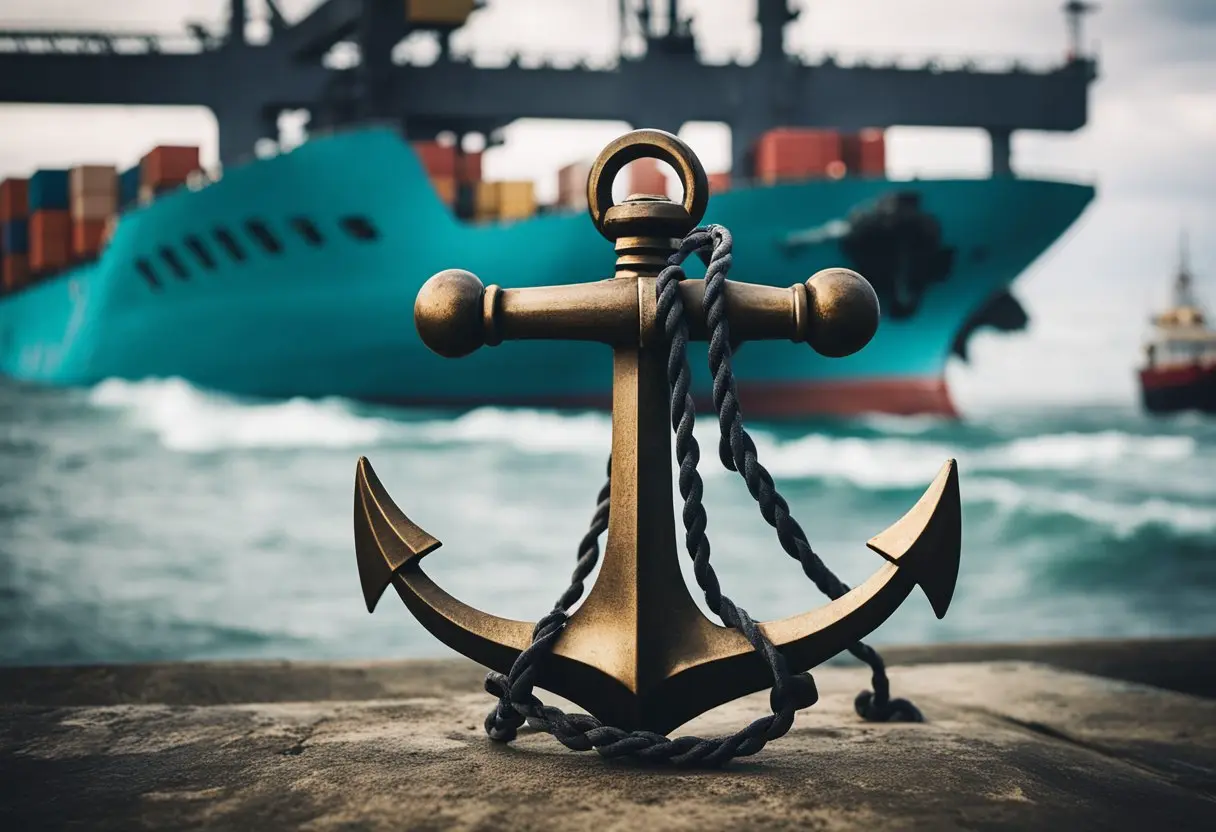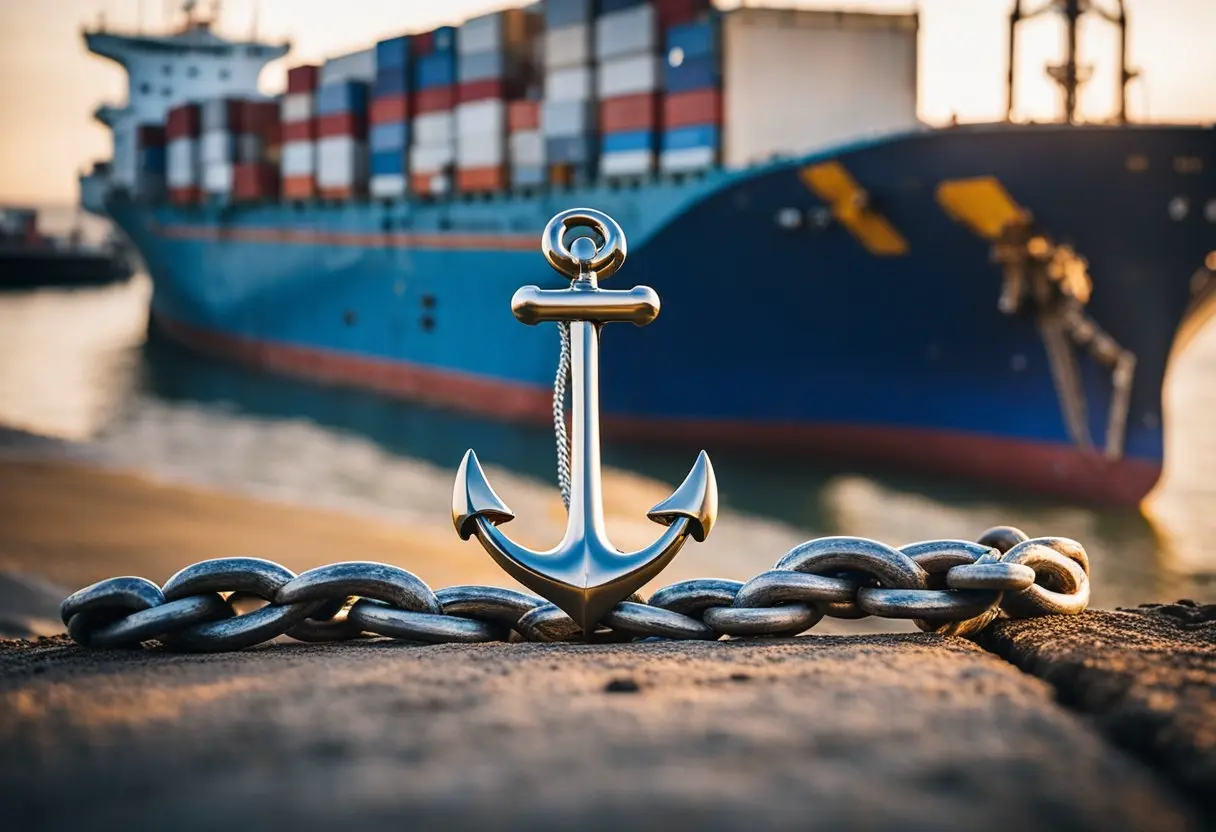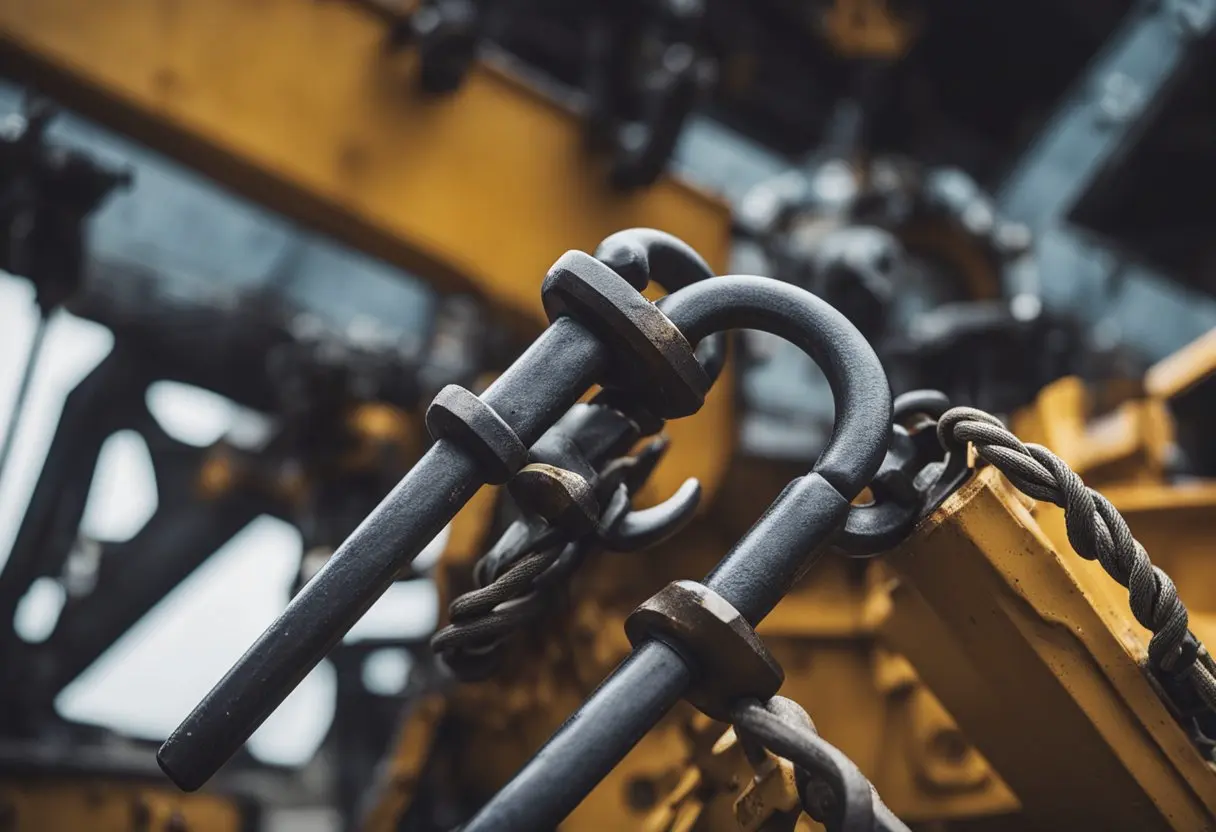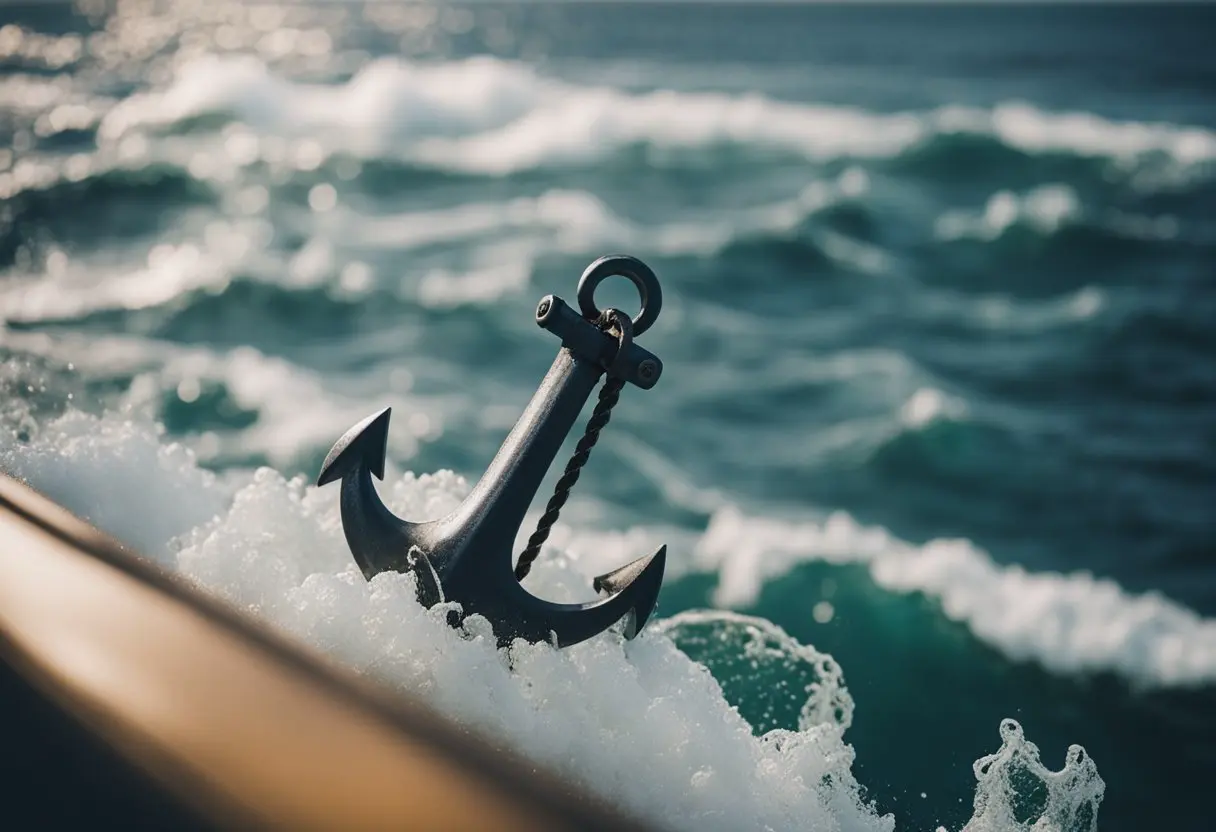How a Tiny Anchor Holds Huge Cargo Ships: An anchor is a device used to keep a ship or boat in a specific location by gripping the seabed. It is a heavy object, usually made of metal, that provides stability and prevents the ship from drifting away. But how does a tiny anchor hold a huge cargo ship in place? This question has been a topic of interest for many people, especially those who are fascinated by the engineering marvels of ships.
The answer lies in the physics of the anchor and the chain. The anchor is designed to dig into the seabed, creating friction that prevents the ship from moving. The chain, which is attached to the anchor, acts as a weight that keeps the anchor in place. The combination of the anchor and the chain creates a powerful force that can hold even the largest cargo ships in place, even in rough seas. Understanding the science behind anchors is essential for anyone interested in maritime operations.
What is Anchor and its purpose on a Ship?

An anchor is a device, usually made of metal, that is used to hold a ship or boat in a particular place. It is attached to the vessel by a cable or chain and lowered to the seabed to hold the vessel in place. The anchor works by digging into the sea bottom using a fluke or pointed projection.
Principles of Anchor Weight and Holding Power
The weight and holding power of an anchor are determined by several factors, including the size and weight of the vessel, the type of seabed, and the weather conditions. The heavier the vessel, the larger and heavier the anchor needs to be to hold it in place. Similarly, the type of seabed also plays a crucial role in determining the holding power of the anchor. Soft or sandy seabeds require larger and heavier anchors, while rocky or hard seabeds require anchors with sharp points or hooks.
The holding power of an anchor is also affected by weather conditions such as wind and waves. In rough weather conditions, the anchor needs to be larger and heavier to provide enough holding power to keep the vessel in place.
In conclusion, an anchor is a crucial device that helps keep a ship or boat in place. The weight and holding power of the anchor depend on several factors, including the size and weight of the vessel, the type of seabed, and the weather conditions. By understanding the principles of anchor weight and holding power, ship operators can select the right anchor for their vessel and ensure that it remains secure in all conditions.
Types of Ship Anchors

A ship anchor is a device that is used to hold a ship in place by attaching it to the seabed. There are several types of ship anchors, each designed for specific conditions and types of seabeds. Here are some of the most common types of ship anchors:
- Fluke Anchor (Danforth): This type of anchor is lightweight and compact, designed for small to medium-sized vessels. It is characterized by sharp, triangular flukes that dig into the seabed. Ideal for sandy or muddy bottoms, it offers good holding power.
- Plow Anchor (CQR): This type of anchor is heavy and strong, designed for larger vessels. It is characterized by a single, curved fluke that digs into the seabed. Ideal for rocky or hard bottoms, it offers excellent holding power.
- Mushroom Anchor: This type of anchor is designed for soft, muddy bottoms. It is characterized by a wide, flat top that creates suction and holds the anchor in place. It is not suitable for use in rough seas or strong currents.
- Stockless Anchor (Hall): This type of anchor is commonly used on large commercial vessels. It is characterized by a flat, triangular fluke that folds up for easy storage. It offers good holding power in most conditions.
- Screw Anchor (Screw-Pile): This type of anchor is commonly used in shallow water, such as near shorelines or in harbors. It is characterized by a long, threaded shaft that screws into the seabed. It offers good holding power in soft, sandy bottoms.
Each type of anchor has its own advantages and disadvantages, and the choice of anchor depends on the type of vessel, the conditions of the seabed, and the weather conditions. It is important to choose the right type of anchor for the specific conditions to ensure the safety of the vessel and its crew.
Anchor Design and Technology
Materials and Construction
An anchor is a device used to hold a ship in place by attaching it to the seabed. The anchor’s design and construction are crucial to its effectiveness in holding a ship in place. Anchors are typically made of high-strength steel and can weigh several tons. The materials used in the construction of anchors must be able to withstand the harsh marine environment and resist corrosion.
The design of the anchor is also important. The anchor’s shape and weight must be carefully calculated to ensure that it can hold the ship in place. The most common types of anchors used on cargo ships are the stockless anchor and the high-holding power (HHP) anchor. The stockless anchor is the most widely used anchor on large cargo ships. It is a compact anchor that is easy to handle and can be stowed in a small space. The HHP anchor has a higher holding power than the stockless anchor and is used on larger cargo ships.
Innovations in Anchor Design
In recent years, there have been several innovations in anchor design. One of the most significant innovations is the use of computer-aided design (CAD) software to optimize the anchor’s shape and weight. This technology allows designers to create anchors that are more efficient and effective in holding ships in place.
Another innovation is the use of new materials in anchor construction. For example, some anchors are now made of composite materials that are lighter and more corrosion-resistant than traditional steel anchors. These composite anchors offer several advantages, including reduced weight and improved performance.
In addition to these innovations, there have been improvements in anchor deployment systems. Some cargo ships now use hydraulic anchor systems that allow the anchor to be deployed and retrieved quickly and safely. These systems are more efficient than traditional manual systems and reduce the risk of injury to crew members.
Overall, the design and technology of anchors have come a long way in recent years. Advances in materials, design, and deployment systems have made anchors more efficient and effective in holding cargo ships in place.
Anchoring Process in ships

Anchoring is a crucial process for cargo ships as it helps to keep them in a stationary position, especially during bad weather or while loading and unloading cargo. The anchoring process involves deploying the anchor, anchor handling and positioning, and anchor retrieval techniques.
Deploying the Anchor
The first step in the anchoring process is deploying the anchor. The anchor is attached to a chain, which is then lowered into the water. The length of the chain depends on the depth of the water. Once the chain is lowered to the seabed, the anchor is released and allowed to sink into the seabed. The weight of the anchor and the chain helps to keep the ship in a stationary position.
Anchor Handling and Positioning
After the anchor is deployed, the ship’s crew must handle and position the anchor properly. This involves ensuring that the anchor is securely fastened to the chain and that the chain is properly tensioned. The ship’s crew must also ensure that the anchor is positioned in the correct location to keep the ship in a stationary position.
Anchor Retrieval Techniques
When it is time to retrieve the anchor, the ship’s crew must use proper techniques to ensure that the anchor is safely retrieved. The crew must first ensure that the chain is properly tensioned and that the anchor is free from the seabed. Once the anchor is free, the crew can begin to retrieve the chain and anchor back onto the ship.
Overall, the anchoring process is a crucial aspect of cargo ship operations. Proper anchoring techniques help to ensure the safety of the ship, crew, and cargo.
Environmental and Physical Factors
Seabed Composition
The composition of the seabed plays a crucial role in the holding power of an anchor. According to a study published in the journal Nature, “the holding capacity of an anchor depends on the type of seabed and the anchor’s design.” The study found that anchors perform best in clay or mud seabeds, while they tend to slip in sandy or rocky seabeds. The researchers noted that the holding power of an anchor is also affected by the depth of the seabed, with anchors holding better in shallower waters.
Weather Conditions and Their Impact
Weather conditions can also impact the holding power of an anchor. Strong winds and currents can cause an anchor to drag, reducing its holding power. The excess chain laid on the seabed can also cause damage to the seafloor, as noted in a study published in RealClearScience. The study found that the anchors of container ships are wrecking the coastal seafloor due to dragging and scouring. The researchers noted that the damage caused by anchors can affect the health of the ecosystem in the long term.
In addition, the size and weight of a ship can also impact the holding power of an anchor. Large cargo ships require larger and heavier anchors to hold them in place. The anchor chain can be hundreds of meters long, and the excess chain lies on the seafloor to stabilize the vessel in waves, wind, and currents.
Overall, the environmental and physical factors that affect the holding power of an anchor are complex and depend on various factors. Understanding these factors is crucial for ensuring the safety and sustainability of the marine environment.
Safety and Regulations

International Maritime Organization Standards
The International Maritime Organization (IMO) is responsible for setting standards and regulations for the safe operation of ships. The IMO has established guidelines for the safe anchoring of ships, which include the use of appropriate anchors and chains, as well as proper procedures for anchoring and weighing anchors. These guidelines are intended to ensure the safety of the crew, the ship, and the environment.
According to the IMO guidelines, ships must have a minimum of two anchors on board, with one anchor being able to hold the ship in place in all conditions. The anchors must be of sufficient size and weight to hold the ship securely in place, even in adverse weather conditions.
Safety Procedures for Anchoring
Anchoring a ship is a complex operation that requires careful planning and execution. Safety procedures must be followed to ensure the safety of the crew and the ship. Before anchoring, the captain must ensure that the ship is in a safe position and that the anchor and chain are in good condition.
When anchoring, the captain must ensure that the ship is positioned correctly, and the anchor is dropped to the seabed in a controlled manner. The anchor chain must be paid out gradually to prevent it from becoming tangled or fouled. Once the anchor is set, the captain must ensure that the ship is holding its position and that the anchor is not dragging.
In addition to these procedures, the crew must be trained in the proper use of the ship’s anchoring equipment and must be familiar with the safety procedures for anchoring. Regular drills and training sessions should be conducted to ensure that the crew is prepared for any emergency situation.
Overall, adherence to these safety procedures and regulations established by the IMO is crucial to ensure the safe operation of ships, especially during the anchoring process.
Case Studies
Historical Anchoring Failures
Throughout history, there have been many instances where anchoring systems have failed, resulting in catastrophic damage to ships and the environment. One such example is the grounding of the Exxon Valdez in 1989, which spilled over 11 million gallons of crude oil into Alaska’s Prince William Sound. The cause of the incident was attributed to the failure of the ship’s anchoring system, which resulted in the ship running aground on a reef.
Another example is the grounding of the Costa Concordia in 2012, which resulted in the death of 32 people. The cause of the incident was attributed to the failure of the ship’s anchoring system, which resulted in the ship running aground on a reef off the coast of Tuscany, Italy.
Success Stories of Modern Anchoring Systems
Over the years, modern anchoring systems have been developed to improve the safety and efficiency of cargo ships. One such system is the Dynamic Positioning (DP) system, which uses advanced computer systems to keep the ship in a fixed position without the need for anchors.
Another modern anchoring system is the Drag Embedment Anchor (DEA) system, which uses a combination of suction and drilling to embed the anchor deep into the seabed. This system is particularly useful in areas where traditional anchoring systems are not effective, such as in deep water or areas with a rocky seabed.
In conclusion, while there have been historical failures of anchoring systems, modern technology has improved the safety and efficiency of cargo ships. The development of advanced anchoring systems such as DP and DEA has ensured that cargo ships can operate safely and efficiently in a variety of different environments.
FAQs About How a Tiny Anchor Holds Huge Cargo Ships
What is the mechanism behind a small anchor securing a large cargo ship?
The mechanism behind a small anchor securing a large cargo ship is based on the principle of friction. When an anchor is dropped, the flukes dig into the seabed, and the weight of the anchor causes it to sink deeper into the sediment. The anchor chain pulls the anchor shank, which creates a horizontal pull force on the anchor. This force causes the anchor to dig deeper into the seabed, creating a holding force that prevents the ship from drifting away.
How do anchors maintain a hold on the seabed for large vessels?
Anchors maintain a hold on the seabed for large vessels by using a combination of weight, fluke design, and chain length. The weight of the anchor helps it sink into the seabed, while the fluke design creates a suction force that helps the anchor hold onto the sediment. The length of the anchor chain also plays a crucial role in maintaining the hold of the anchor. The longer the chain, the more horizontal force it can exert on the anchor, which increases the holding power of the anchor.
What materials are used in the construction of anchors for massive ships?
The materials used in the construction of anchors for massive ships vary depending on the size of the vessel and the type of anchor. However, most anchors for large cargo ships are made from high-strength steel or iron. The flukes of the anchor are often reinforced with steel plates to increase their strength and durability. Some modern anchors also use high-strength alloys, such as titanium, to reduce weight and increase strength.
How is the weight and size of an anchor determined relative to the ship it secures?
The weight and size of an anchor are determined relative to the ship it secures based on the vessel’s size, displacement, and intended use. The general rule of thumb is that the anchor should weigh between 1/30th and 1/40th of the ship’s displacement. However, the size and weight of the anchor can vary depending on the seabed conditions, water depth, and weather conditions.
What are the safety protocols for deploying and retrieving anchors on large cargo ships?
The safety protocols for deploying and retrieving anchors on large cargo ships involve several steps to ensure the safety of the crew and the vessel. Before deploying the anchor, the crew must check the anchor and chain for any defects or damage. They must also ensure that the anchor is properly stowed and secured. During retrieval, the crew must use caution to avoid getting caught in the chain or struck by the anchor. They must also ensure that the anchor is properly secured before stowing it.
How do modern anchoring systems differ from historical methods for large vessels?
Modern anchoring systems differ from historical methods for large vessels in several ways. Modern anchors are often made from high-strength materials and have advanced designs that increase their holding power and reduce their weight. Modern ships also use electric or hydraulic winches to deploy and retrieve the anchor, which reduces the risk of injury to the crew. Additionally, modern ships often use multiple anchors to increase their holding power and reduce the risk of dragging.
